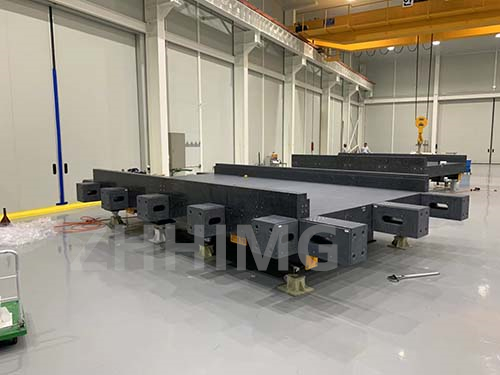Granite machine bases are widely used in various industries for their excellent stability and high accuracy. They provide a solid foundation for precision measurements and minimize the effects of external vibrations and fluctuations. However, due to their heavy weight and rigid structure, granite machine bases can also suffer damages over time, especially from improper handling and accidental impact.
If the appearance of a granite machine base is damaged, it not only affects its aesthetic value but also suggests potential structural flaws and compromises its precision. Therefore, it is important to repair the appearance of the damaged granite machine base and recalibrate its accuracy to ensure optimal performance and reliability. Here are some steps to accomplish this task:
Step 1: Assess the extent of the damage
The first step is to evaluate the extent of the damage to the granite machine base. Depending on the severity of the damage, the repair process may be more complicated and time-consuming. Some common types of damages include scratches, dents, cracks, chips, and discoloration. Scratches and dents can be relatively simple to repair, while cracks, chips, and discoloration may require more extensive work.
Step 2: Clean the surface
Once you have assessed the damage, you need to clean the surface of the granite machine base thoroughly. Use a soft-bristled brush or a damp cloth to remove any loose debris, dust, or grease. Avoid using harsh chemicals or abrasive substances that can further damage the surface.
Step 3: Apply filler or epoxy
If the damage is superficial, you may be able to repair it using a granite repair kit that contains a filler or epoxy. Follow the instructions carefully and apply the product evenly over the damaged area. Let it cure for the recommended time and sand it down with a fine-grit sandpaper or a polishing pad until it blends seamlessly with the surrounding surface.
Step 4: Polish the surface
To restore the appearance of the granite machine base, you may need to polish the surface using a polishing compound and a buffing pad. Start with a coarse-grit polishing compound and gradually move to a finer-grit compound until you achieve the desired level of shine. Be patient and go slowly to avoid overheating the surface and causing more damage.
Step 5: Recalibrate the accuracy
After repairing the appearance of the granite machine base, you need to recalibrate its accuracy to ensure that it meets the required specifications. This may involve using a precision measuring instrument, such as a laser interferometer or a gauge block, to check the flatness, parallelism, and squareness of the surface. Adjust the leveling feet as necessary to ensure that the surface is stable and level in all directions.
In conclusion, repairing the appearance of a damaged granite machine base and recalibrating its accuracy requires some effort and attention to detail, but it is essential for maintaining the quality and reliability of the instrument. By following these steps, you can restore the appearance and functionality of your granite machine base and ensure that it performs optimally for years to come.
Post time: Jan-22-2024

